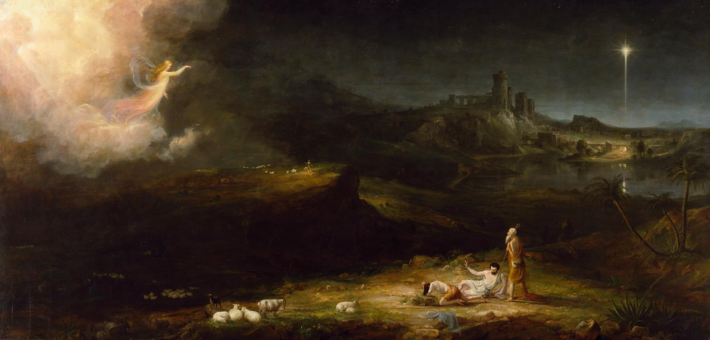Commentary on Isaiah 9:2-7
Isaiah 9:2–7 is a familiar text for Christians because of its association with the birth of Christ. The words of verse 6 are memorialized in Handel’s “Messiah.” In Luke 1:32–33, Gabriel alludes to verse 7 when he announces Mary’s pregnancy. The prophecy contains powerful imagery, including the contrast between darkness and light and the graphic destruction of the implements of war.
Darkness and light
Isaiah 9:2 declares an end of suffering for “the people who walked in darkness.” Darkness symbolizes oppression and hopelessness. For Isaiah’s audience, it had become a way of life. This darkness isn’t just the natural nighttime absence of light. It’s “deep darkness,” a Hebrew word traditionally translated “shadow of death” based on an ancient folk etymology. It’s associated with mines (Job 28:3), prisons (Psalm 107:10), and, above all, the underworld (Job 10:21–22; 38:17).
Then, unexpectedly, “the light shines in the darkness” (John 1:5). For people accustomed to darkness, sudden brightness may be overwhelming, even terrifying. In the midst of anguish, one hardly dares believe things could change. Perhaps that’s why, counterintuitively, the people “see a great light” before it “has shined” in Isaiah 9:2. A distant brightness heralds the possibility of change. Eyes dimmed by darkness can grow accustomed to light before it breaks through. In the words of Emily Dickinson, “The truth must dazzle gradually / or every man be blind.”
The subtle shift from darkness to light marks this season. The amount of sunlight decreases until the shortest day of the year on December 20 or 21. Some churches even hold a longest night or “Blue Christmas” service on the solstice. But then, almost imperceptibly, the amount of light begins to increase. On Christmas Eve, we find ourselves between the two halves of Isaiah 9:2—we’ve “seen a great light,” but we’re waiting for it to shine in its fullness.
Maybe it’s like this every year, but reasons for despair seem plentiful this Christmas. Unprecedented natural disasters. Global political instability. The unending horrors of war. Do we dare heed the call of Advent again this year and exercise our atrophied hope muscles? To take the risk of believing our best days are ahead, not behind? To scan the horizon for a glimmer of a great light that may yet dawn “on a land of deep darkness”?
Happy Christmas! War is over!
Although it’s not included in the lectionary reading, Isaiah 9:1 reveals the historical background of this prophecy: the conquest of northern Israelite territories by Assyria in the late 730s BCE. The threat of invasion remained a continuous reality for Judah and Jerusalem. Little wonder that the “great light” of verse 2 turns out to be an end to war. This theme runs throughout the rest of the text.
The first hint appears in verse 3, which compares the people’s joy to “exult[ation] when dividing plunder.” This image recalls the thrill of victorious soldiers who claim the bounty of their defeated enemies. For too long, Israel and Judah had been the victims of such plunder. Now, in a stunning reversal, they experience the same joy—not because they have become conquerors, but because conquest itself is no more.
Verse 5 powerfully imagines the cessation of war by describing the destruction of soldiers’ uniforms. “Boots of trampling warriors” and “garments rolled in blood” evoke the horrors of military violence. Their burning means such violence becomes a thing of the past. This verse recalls another image of the dismantling of military implements in Isaiah: “They shall beat their swords into plowshares / and their spears into pruning hooks” (Isaiah 2:4). The reason for this extravagant hope is the advent of a new ruler, described in Isaiah 9:6–7. Their administration will be characterized by wise policy (“Wonderful Counselor”) and a commitment to justice and reconciliation (“Prince of Peace”).
Jesus was born into a world of imperial violence, not unlike the eighth century BCE. The census that sent Mary and Joseph to Bethlehem was an effort to solidify Roman control (Luke 2:1–2), and King Herod responded to Jesus’ birth by murdering children to maintain his power (Matthew 2:16–18). Then, as now, God’s surprising answer to violence is the fragile hope of a vulnerable infant. “A child has been born for us” (Isaiah 9:6).
Pre-election postscript
As I write this commentary, it’s two weeks before Election Day in the United States. Not being a prophet, I don’t know who will win or lose that day’s races. It’s difficult at this moment to think about preaching on Christmas Eve, when people sitting in the pews will feel more hopeful or less so, depending on the outcomes of the upcoming elections. Yet, although the future will surely look different by Christmas Eve, it will remain no less certain.
On Christmas and every day, God comes into the messiness of our world, including the messiness of our politics. The grand promises of Isaiah 9:2–7 represented hope for new political leadership. Some biblical scholars even think it was written for the coronation of King Hezekiah. Despite verse 7’s promise of “justice and righteousness … forevermore,” however, Hezekiah failed to enact lasting change. He was succeeded by Manasseh, one of the worst kings in Judah’s history, according to the biblical writers (2 Kings 21:1–18). All human leaders inevitably disappoint. For Christians, the unfulfilled hopes of Isaiah 9 point beyond the human order to the coming rule of God. After all, it is “the zeal of the LORD of hosts [that] will do this” (verse 7).
Our hopes for the future cannot be divorced from our politics, but they cannot be limited to our politics either. Whatever the outcomes of this year’s elections, the promise of Christmas remains the same. We celebrate the limited ways we achieve justice, even as we mourn the persistence of violence and suffering. We walk in darkness, but we strain for a glimpse of the great light that is dawning.


December 24, 2024